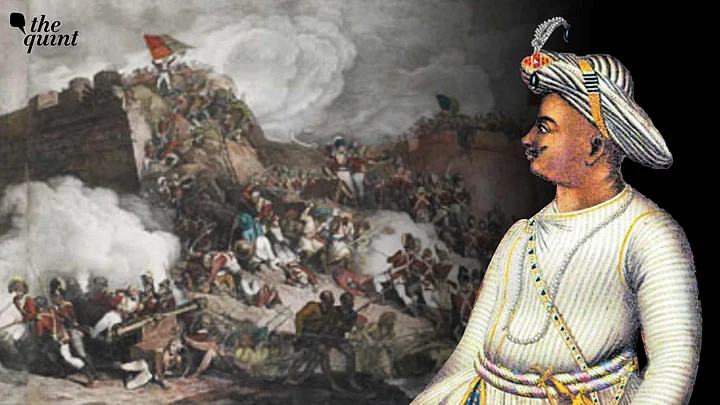As the curator of the exhibition: Tipu Sultan: Image & Distance in New Delhi, Giles Tillotson puts it, “Tipu Sultan presented the most powerful challenge to the might of Britain’s East India Company in the period of its greatest territorial expansion.”
An impressive collection of images, maps and material on Tipu Sultan were procured by Delhi Art Gallery (DAG) from Britain, starting with Henry Singleton’s painting ‘The Last Effort and Fall of Tippoo Sultan' which it acquired two years ago.
This exhibition is a unique one, telling a different story from the ones the month of August marking 75 years of freedom from the colonial rule has been full of.
In keeping with other moves to follow the colonial trend of communal historiography of painting India as a simple 'Hindu versus Muslim' story, Tipu Sultan has been turned into a ‘Muslim’ king, a convertor of infidels and commemoration of his many accomplishments have been portrayed as an ‘appeasement’ of Muslims.
Tipu Sultan Through the Colonial Gaze
This exhibition chooses a very interesting route to get around the biases, prejudice and sometimes hagiography around Tipu Sultan. By reversing the sequence of Indian art being taken abroad, it has subtly used art made for British audiences, shipped it to India to tell the story of how Tipu was seen by his foes, the British in his time, and how much defeating Tipu mattered to them.
The actions of the Maharajas and Nawabs of the late 18th century and certainly after that 'have been dubious', to use a polite phrase, with respect to their stand on colonial control of India.
In the case of Tipu too, the Marathas and the Nizam conspired and allied with the British to ensure his fall. The many recreations of pivotal moments in the Anglo-Mysore wars bear testimony to a ‘Tipu mania’ in British circles when he was killed in the fourth Anglo-Mysore war in 1799.
The importance the British attached to defeating him is clear as you go through the artwork. On display, is also the 'Seringapatam Medal' that was issued by the East India Company, the British lion is shown astride Tipu’s tiger. Historian Janaki Nair describes 4 May 1799, the day he was defeated as “a day of triumph for the British that was etched into historical memory in song, word and art. Britain’s most formidable foe in India had been vanquished.”
Rockets Were No ‘Rocket Science’ to the Mysuru Ruler
There were tremendous riches and goodies for grabs after the fall of his capital, Srirangapatna, but the real prize was in the various technologies that Tipu Sultan had spent time mastering. He had focused on sericulture and on building dams for irrigation but the techniques he perfected in rocketry proved very useful for him in his lifetime and for the British after his death.
His famous rocket technology used an iron tube attached to the bamboo propellant, to fire the fuse and powder. Tipu, till his last days had continued to astound his enemies with it and inflict grave damage on them.
William Congreve, credited with giving the world 'Congreve rockets', used his designs without any attribution. It is no coincidence that he unveiled his designs in 1801-2. Tipu had been defeated in 1799.
Is Tipu's Image Mired In Grand Propaganda Art?
The exhibition showcases different British painters portraying how Tipu may have been defeated. The original painting of Robert Ker Porter imagining the storming of Tipu’s capital was 21 feet high and 120 feet long. It was on display at The Strand in London for nearly a year. Even its reduced reproduction which is on display in Delhi, forces you to step back.
‘The Storming of Seringapatna’ is said to have been painted by Porter at a furious pace, in just two months, and a shilling was charged for every viewing at the Lyceum Theatre in London. The German poet Goethe is said to have sneered at the idea of the panorama art as low-brow and remarked that “a panorama of Tipu Sultan’s terrible end cannot have delighted anyone but those who took part in the plundering.”
But, writes the curator Giles Tillotson, in the remarkable book accompanying the Exhibition that several people thought of the display as spectacular.
It served the purpose of bringing an event they would just read about in the newspaper right onto the streets of London, driving home conclusively the important turning point that winning the fourth Anglo-Mysore battle was, in the Company’s ruthless pillage of the subcontinent.
Tipu: A True Champion of India’s Fight Against the British
That Tipu Sultan’s body was found near the water gate after considerable effort, under a heap of dead soldiers, speaks of his raw personal courage. It fed tales of his heroism immediately afterwards. The British found it necessary to bring in the Wodeyars and turn them into rulers of Mysore, to disrupt Tipu Sultan and his father, Haider Ali’s legacy. Tipu chose to fight and died fighting, unlike the many rajas and maharajas of his time who were happy to compromise, strike deals and often betray later-day nationalists fighting the British Crown.
In a nutshell, coming as it does in a season of celebrating valour, courage and significance of greats beyond the pantheon of the national movement of the 20th century, the Tipu exhibition asks a blunt question:
Each of the larger-than-life artworks seem to pose just one query to those anxious to deny India’s varied canvas -- how can a fighter of his calibre, so feared by the British be airbrushed out of India’s impressive line-up of those who fought them to their grave?
(Seema Chishti is a writer and journalist based in Delhi. Over her decades-long career, she’s been associated with organisations like BBC and The Indian Express. She tweets @seemay. This is an opinion article and the views expressed above are the author’s own. The Quint neither endorses nor is responsible for the same.)
